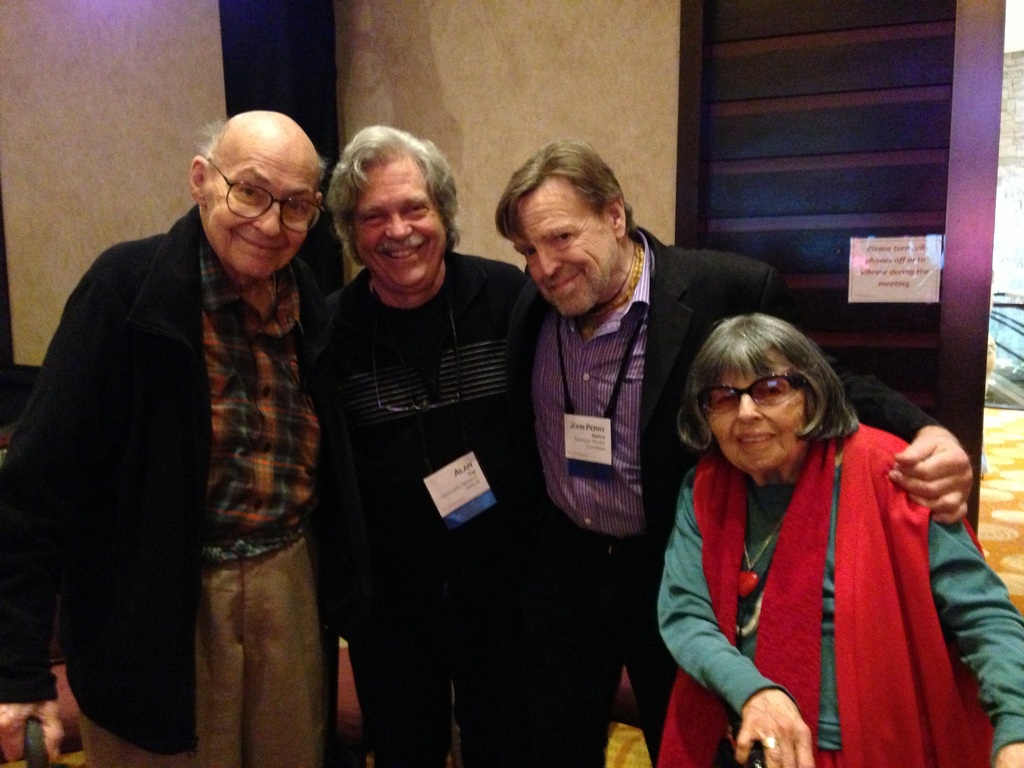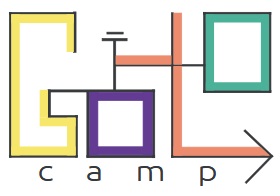Alan Kay and Marvin Minsky: Computer Science already has grammar. Need "literature"
- Transfer

The first on the left is Marvin Minsky, the second on the left is Alan Kay, then John Perry Barlow and Gloria Minsky.
Question: How would you interpret Marvin Minsky's idea that “Computer Science already has a grammar. What she needs is literature. ”?
Alan Kay: The most interesting aspect of Ken's blog post (including comments) is that there is no historical reference to this idea anywhere. In fact, more than 50 years ago in the 60s there was a lot of talk about this and, as far as I remember, several articles.
I first heard about this idea from Bob Burton, in 1967 at the magistracy, then he told me that this idea was part of the motivation of Donald Knuth when he wrote “The Art of Programming”, whose chapters were already going around. One of Bob’s main questions then was about “programming languages designed to be read by humans as well as by machines.” And that was the main motivation for parts of COBOL design in the early 60s. And, perhaps more importantly in the context of our topic, this idea is visible in the very early and rather beautifully designed interactive language JOSS (mainly Cliff Shaw).
As Frank Smith noted, literature begins with ideas that are worth discussing and writing down; it often partially generates representations and extends existing languages and forms; this leads to new ideas about reading and writing; and finally, to new ideas that were not part of the original motive.
Part of the idea of “oliteraturization” is reading, writing, and links to other articles that may be of interest. For example, Marvin Minsky’s lecture at the Turing Prize begins with “The problem with Computer Science today is the obsessive concern for form, not content . ”
He meant that the most important thing in computing is the meaning, and how it can be considered and presented, unlike one of the big topics of the 60s on how to analyze programming and natural languages. For him, the most interesting thing in the thesis of a graduate student Terry Vinograd could be that at the same time it was not very true in terms of English grammar (it was very good), but that it could give meaning to what was said and could justify what was said using of this value. (This is an echo of the past from what Ken reports on Marvin's blog.)
A parallel way to take a look at “ubiquitous language”. A lot can be done without changing the language and even without adding a dictionary. This is similar to how it is very easy to write a formula with mathematical symbols and syntax. This is partly what Marvin is leading to. It's funny that the Turing machine in Marvin’s book “Calculation: Finite and Infinite Machines” (one of my favorite books) is a pretty typical computer with two instructions (add 1 to the register and subtract 1 from the register and branch to the new instruction if the register is less than 0 - There are many options.)
This is a common programming language, but pay attention to the pitfalls. A reasonable solution to the “ubiquitously studied” should also have certain types of expressive power, which are likely to require more time to study.
Don’s interest in the so-called “literate programming” led to the creation of an authoring system (historically called WEB) that would allow Don to explain the program itself, which was written, and which included many functions that allow you to extract parts of the program for human study. The idea was that the WEB document was a program, and the compiler could extract compiled and executable parts from it.
Another early innovation was the idea of dynamic media, which was a popular idea in the late 60s, and for many of us it was an important part of interactive computing on a PC. One of the several motives for this idea was to have something like the “Newton Principles” in which “mathematics” was dynamic and could be run and tied to graphics, etc. This was part of the motive to promote the Dynabook idea in 1968 year. One of the terms that began to be used then was “active essay”, where the types of presentation and argument that can be expected in the essay are enhanced by the fact that the interactive program is one of many types of media for a new type of document.
Some very good examples were made in Hypercard by Ted Kyler himself in the late 80s and early 90s. Hypercard was not directly configured for this - the scripts were not multimedia objects for the cards, but you could do some work and get the scripts to display on the cards, as well as make them interactive. A particularly provocative example was Weasel, which was an active essay explaining part of Richard Dawkins’s book Blind Watchmaker, allowing the reader to experiment with a framework that used a kind of breeding process to find targeted sentences.
It’s worth considering that, despite the fact that Hypercard was almost perfect for the Internet that appeared - and its widespread adoption in the early 90s - the people who created the Internet decided not to accept either Engelbart’s larger ideas. And Apple, which had a lot of ARPA / Parc people in its research wing, refused to listen to them about the importance of the Internet and that Hypercard would be great at starting to use a symmetrical reading and writing system. Apple refused to make a browser at a time when a really good browser would be a significant event, and perhaps it would play a huge role in what the “public face” of the Internet turned out to be.
If we move forward for several years, we will find the absurdity — even the almost obscene — of a web browser without a real development system (think how silly wiki development should have worked), and as one of many simple examples, a Wikipedia article like LOGO running on a computer, but not allowing the reader to try to program LOGO from the article. This meant that what was important for computers was blocked for users in defense of various options for implementing old media.
It is worth considering that Wikipedia was and is the main genre for reflection, invention, implementation and writing of the “literature of calculations”, which is necessary (and this, of course, is associated with both reading and writing many types of multimedia, including programming).
It’s worth even more to think about the fact that I can’t write a program here in this answer to Quora - in 2017! “This will help show what exactly I'm trying to explain, despite the tremendous computer power that underlies this weak idea of interactive media.” The important question “what happened?” Is completely overlooked here.
To get an idea of the problem, here is the 1978 system, which we partially resurrected several years ago to pay tribute to Ted Nelson, and partly for fun.
(Please take a look here at 2:15)
The whole system is an early attempt to implement what I am talking about more than 40 years ago.
A vivid example can be seen at 9:06.
Besides the “dynamic objects”, one of the key considerations here is that the “views” - the media that are visible on the page — can be processed uniformly and independently of their contents (we call them “models”). All this is a “window” (some of them have explicit frames, and some do not display their frames). All of them are compiled on the project page. Another understanding was that since you have to compose and combine some things, make sure everything is composable and compositional.
I think that inexperienced users can be forgiven for not criticizing bad projects. But programmers who make interactive media for users and who don't care about learning about the media and design, especially from the history of their own field, should not get away with it so easily and should not be rewarded for they are "weaker."
Finally, a field without real literature is almost equivalent to the fact that this field is not a field. Literature is a way to preserve great ideas in a new genre, and in present and future thinking in this area. This, of course, is not present in the computation to any useful degree. Like pop culture, computing is still most interested in what can be done without extensive training, and where performance is more important than the consequences of the results. Literature is one of the mediums where one can go from simple and direct to larger and more important.
We need it!
About GoTo School

- June 17-30, July 15-28, August 12-25 Summer GoTo design school programming in the suburbs.
- Group in VK
- Subscribe to Newsletter
